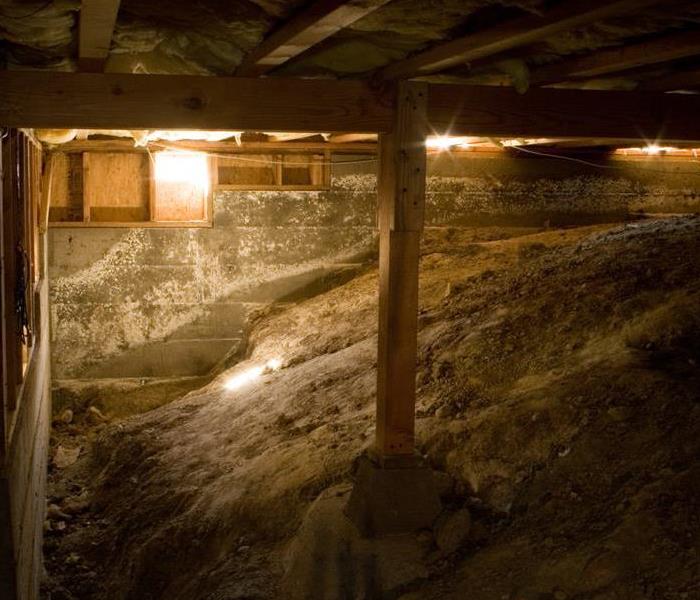How Do I Address Flooding in the Crawlspace of My Tallahassee Home?
6/12/2020 (Permalink)
Flooding can be a hazard to all exposed, so it is crucial to resolve this disaster as soon as possible.
Natural flooding is one of the most destructive situations for many Tallahassee homes throughout the year. With the probability of flooding, especially in the rainier seasons, many homes have gotten constructed with crawl spaces. While this provides more convenient access to utilities tucked neatly beneath the main floor of the house, it also suspends the property and protects it from much of the destruction that flooding can do.
There are several considerations for the property owner when contending with this flood damage in your Tallahassee home. The first is understanding how the flooding in the crawlspace can impact the rest of the house. Understanding the steps necessary to restore and protect this area can help you appreciate securing skilled technicians like our SERVPRO team as soon as possible.
Can Flooding in a Crawlspace Affect the House?
While you might be among the many that consider flooding in the crawlspace and not your home to be an averted crisis, this might not be as harmless as it might initially appear. Several pressing concerns exist when standing water persists underneath your home. Identifying potential problems and understanding the severity of natural flooding can lead you to four primary conditions:
- Microbial Threats – Persistent water damage and an elevated moisture content can provide the ideal conditions for the development and spread of microbial colonies. Mold and fungal threats can be a hazard to those exposed, and these colonies can pass through the flooring to impact occupants of the property above the crawlspace.
- Moisture Wicking – With wooden supports and subflooring, direct exposure to flood water can allow porous materials like wood to absorb this water and move it within the material to structural supports, joists, and framework.
- Structural Deterioration – After prolonged exposure to standing water and trapped moisture in the materials, wood framework and other exposed materials can begin to deteriorate and degrade.
- Contamination – One of the pressing concerns of natural flooding is potential contamination. Nearly all natural flood situations must be treated like blackwater instances, assuming that the migrating water encountered hazardous bacteria, sewage, viral pathogens, and other germs.
How Can Water Get Removed from this Area?
Extraction and drying are vital concerns to avoid many of the situations that could develop. As with nearly all conditions relative to flood exposure, longer wait times can make things much worse. We have sophisticated water removal and drying tools that can remove surface water, even standing water with solids and debris. The right choice in removal equipment can impact the overall efficiency of restoration and get you back into your home more quickly. Some of the practical extraction tools in our arsenal include:
- Trash Pumps
- Truck-Mount Extractors
- Wet Vacuums
How Can Mold Get Prevented?
Even though considered to be a secondary effect, you cannot seek to address a natural flooding situation without considering the possibility of mold. Removing colonies as they develop is one strategy, but when possible, our technicians work to remove the possibility. Preventing microbial growth and restoring potential hosting materials involves several specific strategies, including:
- Applying Antimicrobial Agents – We have many powerful antimicrobial cleaning products and agents that can be applied directly to sensitive materials in the region of migrating mold colonies to inhibit mold development or thwart the growth and expansion of early-stage mold colonization.
- Drying Out Damaged Areas – Removing the supporting conditions is an effective strategy to starve out colonization. Without the appropriate conditions for colony survival, combined with other remediation tasks, we can gain control of a mold-damaged portion of the property.
- Soda Blasting Surfaces – Abrasive techniques like soda blasting are effective methods of removing surface threats and the embedded hyphae of the organism. Sanding is also one of these same practices that can remove surface threats.
How Can This Get Prevented in the Future?
Flooding in a crawlspace can be a considerable challenge when you do not realize the impact this occurrence has on the house. Preventing this situation is not impossible, but requires some permanent solutions like crawlspace encapsulation. This practice covers all of the exposed open areas beneath the property with thick plastic sheeting. It also installs permanent diversion implements like sump pumps or drainage to keep flooding from occurring beneath the house again.
No matter how severe flooding might be in your home or crawlspace, our SERVPRO of North Leon County professionals can help. We have a team of technicians standing by 24/7 at (850) 536-6599.





 24/7 Emergency Service
24/7 Emergency Service